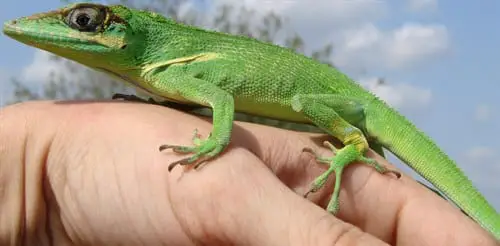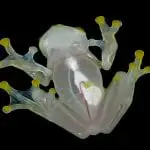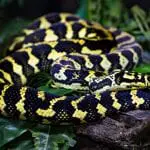Scientific Facts
| Common Name: | Knight Anole |
| Scientific Name: | Anolis equestris |
| Life Span: | 8 to 12 years |
| Size: | 12 to 19 inches |
| Habitat: | Trees, woodlands |
| Country of Origin: | Cuba and introduced in Florida |
Physical Description
The Knight Anole is a reptile that is a member of the anole family. These reptiles are actually the largest members of the anole species and are usually a foot to 1.5 feet long in terms of their overall size. Knight Anoles also weight a maximum of about 4.83 oz. They are not very big compared to other pet reptiles, but that does not take away the fact that they are bigger than any other reptile of the anolis family. Knight Anoles were once native to Cuba but were introduced as pets in Florida back in the 1960s and eventually became native to that region when certain pets either escaped or were released from captivity.
The snout of the Knight Anole tends to be quite long and has a shape that resembles a wedge. Under its mouth is a dewlap or a flap of skin that extends all the way to the end of the neck where the Knight Anole’s body starts. This dewlap is actually quite big and is wider than the reptile’s entire head. Most Knight Anoles have dewlaps that are whitish to pinkish in terms of color.
Most Knight Anoles are usually bright green in terms of their overall color, although there are parts of their body that have different colors (such as its pinkish dewlap). However, this reptile can also change its color depending on the situation. They can even change to a dull color of brown in some cases or turn dark green whenever they feel threatened. The head also usually has a brownish stripe on top of it. Nevertheless, it is mostly bright green on any ordinary day. The Knight Anole’s body is also covered with different small scales that are quite granular.
The toes of the Knight Anole each have long adhesive pads that allow it to stick on different kinds of elevated surfaces given the fact that this reptile is extremely arboreal and will always most likely be on an elevated spot. The pads also allow it to run up vertical and horizontal surfaces quickly and smoothly without any trouble. To the untrained eye, the pads may look like claws because of their elongated form, but they are actually adhesive pads.
Male and female Knight Anoles have certain differences. The males are usually the bigger ones compared to the tinier females. Males are also usually the ones that display that white-pinkish dewlap. When the male Knight Anole gets excited, this dewlap may swell up from the inside. In all other cases, you will also notice several other differences, such as how males are shaped differently compared to females and how most males are usually brighter in terms of color compared to their female counterparts. There are also cases when males and females have different patterns on their bodies. As such, it will be easy to distinguish a male Knight Anole from its female counterpart.
Lifespan
In captivity, the Knight Anole is believed to have a lifespan of about 8 to 12 years. Most Knight Anoles that are in captive care usually live an average of about 8.3 years. However, there is no reason to believe that these reptiles cannot live for more than 12 years as long as they are given the proper care and nutrition they need to thrive well. It is also believed that Knight Anoles in the wild have a shorter lifespan because of the presence of different life-threatening factors such as predators (snakes, birds, larger lizards, or even some mammals) and parasites.
Eating Habits
Knight Anoles are mostly carnivores (but are believed to show omnivorous tendencies) and will most likely eat food that is meat-based. And since these reptiles are arboreal in nature, they have a diet that is composed regularly of different insects and invertebrates that can be found on trees or in elevated places. As such, Knight Anoles found in the wild regularly eat all sorts of insects such as crickets, cockroaches, worms, spiders, and moths. There are even instances wherein these reptiles will eat other smaller lizards because of how voracious their eating tendency is. In fact, Knight Anoles display cannibalistic tendencies in the sense that they will also eat young or juvenile Knight Anoles when given a chance to do so. However, there are studies that show that the Knight Anoles are not as cannibalistic as other species of anoles. Still, you should not risk it by housing a smaller Knight Anole with a much larger one. All that considered, they are best given a diet that is based on insects and on the occasional lizard.
In captivity, you should give your Knight Anole a diet that is composed of different types of insects such as crickets and mealworms. Most insects are high in phosphorus, so it is better to dust them with a calcium supplement first before feeding them to your reptile so that your pet’s calcium and phosphorus levels balance out (you will know the importance of this later on). And because insects are not complete in terms of overall nutrients, what you should do to them first before feeding them to your Knight Anole is to gut-feed them. Gut-feeding is the process of feeding the crickets or the mealworms with nutritious greens just a few hours before you feed them to your Knight Anole so that the pet reptile also gets to benefit from the nutrients that come from those healthy greens. In some cases, you can also feed your Knight Anole with small lizards as an occasional treat. The larger ones also will not hesitate to eat mice so long as they are small enough to fit in its mouth.
The reason why Knight Anoles are also considered omnivorous is that they may also eat fruits from time to time. In the wild, they are known to be seed dispersers because of their tendencies of eating fruit whole and then dispersing the seeds away from the parent plant through any means. As such, they play a very important role in the wild. In captive care, however, their role as seed dispersers might not have any importance, but you should still feed them fruits from time to time because of the nutritional contents found in them. You can provide them with berries, bananas, or apples. When feeding them with fruits, try to go for the ones that are soft. Sometimes, these reptiles may even feed on greens such as vegetables like lettuce.
Knight Anoles really are not very difficult to feed because they are quite active when it comes to feeding. There are some owners that tend to tease their pets by poking them with the prey item using tweezers. However, you can also offer the insect to them live by simply leaving the prey items in their enclosure and then wait for the Knight Anole to hunt them on its own. When feeding your Knight Anole, try not to use your bare hands when offering them their food as they are quite shy and will not hesitate to bite you in the act of self-defense. Again, use tweezers or anything similar when offering them their food. Keep feedings scheduled as well because of how these reptiles have a tendency of overfeeding due to their insatiable appetites.
Sleeping Habits
Knight Anoles are diurnal reptiles that spend the majority of the day active. While awake during the day, they can be found on top of trees and on branches hunting for prey. In the night, they are most likely asleep in elevated places. In captivity, lights should be kept on during the day and off during the evening to provide your Knight Anole with a natural light schedule they can follow. During the colder seasons, you might want to use a heating pad instead of a heat lamp so that you won’t disrupt your Knight Anole’s natural light schedule.
Water
Like many other reptiles that are arboreal in nature, the Knight Anole gets its water by drinking it off of the drops that fall from leaves. They rarely drink water by going down on the ground and looking for a constant water source, unlike other arboreal reptiles that may go to a nearby stream, river, or pond from time to time for a drink of water or to soak their bodies. In that sense, the best way to provide your Knight Anole with water is to mist its enclosure from time to time so that it can catch water off of the leaves you have in its habitat. However, if you really are concerned with its water drinking habits, you may want to provide it with a water dish inside its enclosure even though there is only a very small chance that your Knight Anole will drink from it.
Breeding
Sexing is the first thing you need to do when you are breeding Knight Anoles. Unlike other reptiles, this is fairly easy to do with Knight Anoles because of how males and females look different from one another. The male Knight Anoles have bigger dewlaps that are colored pink. They are also a lot bigger and more muscular than females. On top of that, males and females have differences in terms of body structure, color (males are more brightly colored), and patterns on the body. In that sense, you can easily tell them apart when you want to breed them. However, you should be careful with this because Knight Anoles do not know how to distinguish males and females and will sometimes try to mate with a fellow male.
Breeding in Knight Anoles usually occurs during the summer when the season is at its hottest. In America, it can happen during a hot spring or exactly during summer. In the wild, Knight Anoles court by fighting for the affection of a female that wants to reproduce. The winning male will also fight with the female to try to copulate with it. Copulation happens when the more dominant male finally forces the female into submission.

Common Health Problems
Knight Anoles are just like any other pet reptile in the sense that they may be very hardy and resilient creatures but are still prone to common health problems that can potentially cut their lifespan short if you are not too careful with the way you look after them and if you are not quick to find remedies for whatever health issue your Knight Anole has. In many ways, Knight Anoles have health problems that they share with many other different types of reptiles.
For one, the Knight Anole is prone to obesity because they are active eaters and will most likely eat whatever you offer them. To that end, you should be careful with the regularity of their feedings because of how these reptiles can overfeed without them knowing that they have already eaten more than what they should. Obesity can lead to a lot of different health complications and might render the Knight Anole unable to hold its own weight whenever it climbs up trees and branches. There is even a danger that an overweight Knight Anole will fall and hurt itself when climbing up.
Knight Anoles are also just as prone to metabolic bone disease as many other types of reptiles due to how its diet is regularly composed of invertebrates that are high in phosphorus and low in calcium (due to their lack of bones). Metabolic bone disease can lead to brittle and weak bones and may even lead to deformities in your reptile. A Knight Anole suffering from this disease will most likely be weak and will not be able to move as well as it should due to how weak its bones, joints, and muscles are.
Lastly, Knight Anoles can easily suffer from respiratory infections that are caused by bacteria and changes in environmental conditions that are not suitable for it. An enclosure that is either too cold and too damp for your Knight Anole will leave it vulnerable to respiratory infections. Symptoms of this illness may include fatigue, lack of appetite, wheezing, and the presence of mucus.
Preventing Illness
The best way to prevent illnesses in your Knight Anole is to know the most common types of health problems it encounters and to know how to minimize the risk of your reptile from encountering such illnesses and problems. After all, prevention is always better than the cure for certain types of diseases, illnesses, and health conditions.
Obesity can easily be remedied by putting your Knight Anole on a strict feeding schedule so that you can avoid overfeeding this reptile. The thing with Knight Anoles is that they should be fed on a daily basis. However, they should only be fed once a day with meals that are just enough for them. Hatchlings and juveniles should be fed daily as well, but you may want to feed them with large meals because of how they need additional calories for growing.
Meanwhile, the best way for you to avoid metabolic bone disease is to make sure you feed your Knight Anole with invertebrates that were dusted with a calcium supplement so as to balance out the calcium and the phosphorus levels in their bloodstream. Providing them with an ultraviolet B lamp is also a good idea because of how a UVB lamp provides them with vitamin D3, which allows them to metabolize calcium better and more efficiently.
When it comes to making sure that they do not get to suffer from respiratory illnesses, always keep an eye on the temperature and humidity levels. They should be placed in an environment that mimics their natural habitat in the wild as much as possible. The conditions should not be too cold or too damp for the Knight Anole so as to prevent respiratory infections. On top of that, bacteria can also build up easily if your Knight Anole’s conditions are too damp.
Lastly, sanitation is very important in making sure that your Knight Anole’s enclosure is free of any bacteria, molds, and harmful micro-organisms. Always try to spot clean the enclosure as much as possible, but it is also important that you sanitize the habitat from time to time so that you will prevent harmful bacteria from building up inside. Parasites, both internal and external, can also be prevented if you clean and sanitize the entire enclosure at least maybe once a month.
Behavior
Knight Anoles display all sorts of unique behaviors that make it a very good pet to have aside from the fact that its bright green colors are a sight to behold. Just observing or looking at this pet lizard is already a treat because of how it may do things that some other types of pet reptiles do not do. However, there are also certain types of things they do that you should keep an eye on.
It will be common to see your Knight Anole spending the entire day on top of a branch or an elevated spot because of its nature as an extremely arboreal reptile. It hardly goes down to the ground even when it is hunting or when it needs to drink water. That is because this reptile is rather shy and prefers to feel safe on top of a branch or any other similarly elevated spot in its enclosure.
These reptiles are very different compared to other pet lizards in the sense that they are very quiet, shy in a very defensive way. Aside from the fact that they want to feel safe, they are also not afraid of attacking or biting anything that they deem a threat. A Knight Anole will not be afraid to bite a human even if it is its owner or handler so long as it does not feel safe. Also, one other thing you should take note of is that Knight Anoles are very defensive when it comes to snakes or anything that looks similar to a snake. It will attack or act in a defensive way whenever it sees something that is elongated (such as a garden hose or even a stick). As such, always makes sure that you keep anything that looks snake-like from your Knight Anole. If it sees anything that it thinks is a threat, it will gape in a menacing manner and will turn a darker but brighter shade of green, and even do head bobs in an attempt to scare off its perceived attacker.
Knight Anoles are also extremely territorial. Males do not like being with other males because of their nature as territorial reptiles. Some Knight Anoles are also territorial towards females because they actually struggle to tell the difference between a male and a female Knight Anole. On top of that, Knight Anoles display carnivorous tendencies and may actually eat another Knight Anole that is smaller than it is. As such, it is best to keep it in its enclosure alone and without any other Knight Anole or lizard.
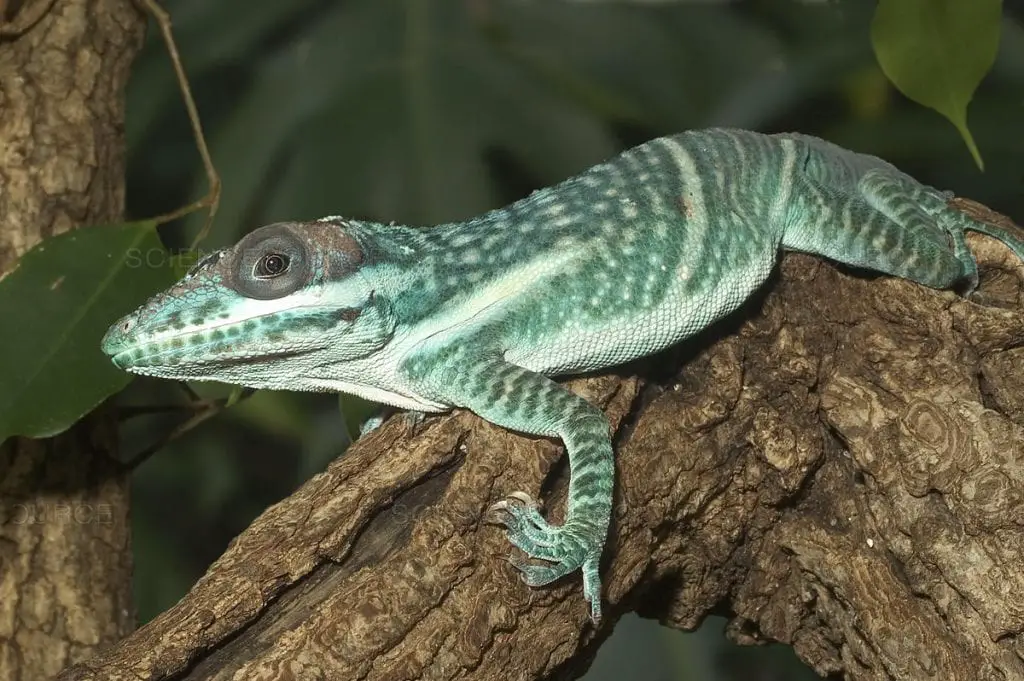
Hibernation Cycle
Due to the fact that Knight Anoles are native to regions that are quite tropical in nature, such as Cuba or even Florida, it is not normal for them to experience winters. In that sense, they normally do not hibernate, but they may actually experience a period of dormancy whenever the season gets too cold for them. Try to keep the heat up for them even during the winters so that they will not be forced to go into a state that is similar to hibernation. You may want to add another heat source to the enclosure if you want to keep things warm for your Knight Anole even during the winter season.
Habitat
The great thing about the Knight Anole is that it is not a very demanding reptile when it comes to the type of enclosure it needs. You may want to provide it with a glass reptile terrarium that is higher than it is wide. There may be reptile terrariums available in your local reptile stores, but you can make your own one out of plywood and glass. See to it that the glass part of the terrarium or the enclosure acts as a window for you to observe your Knight Anole. Also, to keep things moist and to improve the humidity in the enclosure, see to it that the terrarium has small openings where air can pass through well enough. You can use a screen lid on top of the terrarium because of how it allows air to flow in and out of the enclosure freely.
For your Knight Anole’s enclosure, it might be best to buy or build a terrarium that is high. It must be at least 4 feet in height because Knight Anoles prefer to stay on top of branches that are about 3 feet high off the ground. The good thing here is that the enclosure will not need to take up a lot of space in your room because you can go for a terrarium that is at least 2 feet wide. But it might be best for a 3-foot wide terrarium so that you can add more furnishings.
Speaking of furnishings, it is essential that you decorate your Knight Anole’s enclosure really well because of its nature as an arboreal reptile. Strong and sturdy plants or small trees that have branches are important so that the reptile will have something to climb on. The key here is to provide plenty of foliage this reptile is an avid climber that will spend most of its life on a branch or on something that is elevated. Having plants with large enough leaves is also ideal because the Knight Anole likes to drink water from drops that it catches from the leaves in its enclosure.
Lighting and Humidity
When providing a good light source for your Knight Anole, you may want to invest in two types of light. The first one should be a UVB lamp that provides vitamin D3 for your reptile. This allows it to metabolize calcium better so that you can minimize the risk of it suffering from metabolic bone disease. Another type of light should be a strong heat lamp that provides the majority of the light and the heat in the enclosure. The main purpose of a heat lamp (such as an incandescent lamp) is to make sure that your reptile follows a natural light schedule.
Meanwhile, when it comes to humidity, Knight Anoles require a very humid environment that has humidity levels that are somewhere between 50% and 80%. To achieve such humidity levels, you should regularly mist the reptile’s enclosure with water. This allows the habitat to stay damp and humid. Misting is also the best way to provide the Knight Anole with the water it needs for drinking. And though a water dish does not have a lot of purposes as to your reptile’s hydration needs, it can also keep humidity levels up. The best way to know that the enclosure is humid is to check the substrate and to make sure that it stays damp or moist.
Temperature
Knight Anoles are used to environments that are warm and tropical. The best way to provide your reptile with the heat or warmth it needs is to use lighting sources such as a UVB lamp or an incandescent heat lamp. The coldest portion of the entire enclosure should have temperatures of somewhere between 70 and 80 degrees. This should be where the UVB lamp should be placed because it does not emit a lot of heat.
Meanwhile, there should be a really hot portion in the enclosure because of how the Knight Anole requires a basking area after eating. The temperature in the hottest portion of the enclosure should be somewhere between 95 and 100 degrees. This hot portion is probably directly under the heat lamp because that is where the majority of the warmth it emits should be.
Shedding
Knight Anoles shed their skin from time to time as their body grows. This is intended for new skin to grow in place of the old one. Shedding is more common in younger Knight Anoles because of how they are still rapidly growing. Knight Anoles are not like snakes in the sense that they do not shed their skin whole. Instead, some Knight Anoles may shed skin from a certain part of its body first. To make shedding easier for your reptile, it needs to keep its skin hydrated and moist.
Sanitation
Providing your Knight Anole with a habitat that is clean and sanitary is one way of keeping it safe from any sort of harmful illness or health problem. Always see to it that you spot clean the enclosure whenever you see feces or anything dirty. However, to make sure that the entire habitat is sanitary, fully sanitize it about once a month to kill off bacteria, molds, and other harmful micro-organisms. You may want to use a sanitization solution made from water and vinegar.
Natural Environment – Substrate
Though the Knight Anole rarely spends time on the ground because of its arboreal nature, you still need to put a really good substrate in its enclosure to act as bedding of sorts and to keep things moist. Cypress mulch is a good choice because of how it holds moisture really well, but you can also go for newspapers or coco fiber. Avoid using fertilized garden soil because of how it might harm the Knight Anole when it unintentionally swallows it when it is feeding.
Hydration
Knight Anoles drink their water from drops that fall of leaves after misting its enclosure. They rarely drink water from water dishes, but you may still provide them with one just to make sure that they have a constant supply of water in their enclosure. But misting the enclosure with water is still the best way for you to keep your Knight Anole hydrated. Mist the enclosure on a regular basis because it does not only provide water for drinking, but it also keeps everything moist and the conditions damp and humid.
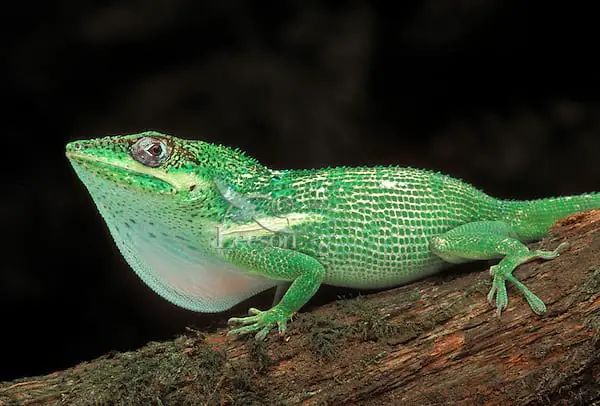
Availability – Where to Get One?
Knight Anoles are fairly easy to get in the United States because they are common in Florida. As such, there are plenty of wild-caught Knight Anoles being sold. While that is not entirely a bad thing, wild-caught reptiles might not be the friendliest pets. Instead, go for those that sell captive-bred Knight Anoles because they are friendlier and easier to care for. Either wild-caught or captive-bred Knight Anoles are pretty common in many pet stores. You can get them for a low price of about $10 because of how common they actually are.
How to Care for a Knight Anole?
Here are some tips on how to care for a Knight Anole
- Knight Anoles are active and voracious eaters that need to be fed regularly but in moderate portions to minimize the risk of obesity, which is a very common health problem for them.
- You may be able to safely house a Knight Anole together with another one so long as it is of the same size as larger Knight Anoles may actually eat the smaller ones. However, avoid housing a male with another male because of the Knight Anole’s extremely territorial nature.
- A Knight Anole’s enclosure should be high instead of wide because of their arboreal nature. Make sure that you decorate the habitat with trees with branches.
- Knight Anoles may bite you because of their shy tendencies. As such, keep handling to a minimum.
FAQ Section
Do Knight Anole’s bite humans?
Knight Anoles have a tendency to bite humans because of how shy and defensive these reptiles are. In that regard, keep handling to a minimum so as to avoid any injuries.
Are Knight Anoles good for beginner owners?
As far as taking care of them, the Knight Anole is quite easy to take care of. However, they are not the best pets for beginner owners who like to handle their reptiles because of how the Knight Anole does not like getting handled.
Can Knight Anole change colors?
Knight Anoles can change their colors. They are usually either brown or green, depending on the situation.
Are Knight Anoles dangerous pets?
As far as actual danger is concerned, the Knight Anole really isn’t very dangerous because they are not venomous and are not very aggressive. However, as to their tendency of biting humans, they may actually be dangerous because they are quite shy and defensive.
Can you keep two Knight Anoles in the same enclosure?
Two male Knight Anoles should never be housed together because of their territorial nature. The same could be said of one bigger Knight Anole and a smaller one. However, you may house two female Knight Anoles of the same size.

